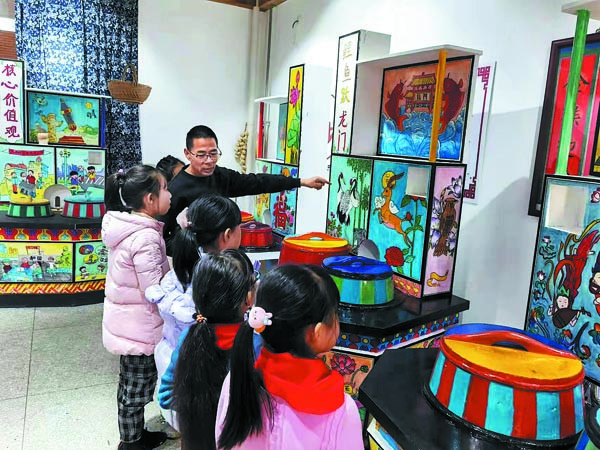
Zaotou painting professional Zhao Shengbo introduces the traditional art form at a primary school in Jiaxing, Zhejiang province. (Photo/China Daily)
Decorative stove artwork attracts a growing number of admirers, who relish the memories it evokes, Yang Feiyue reports.
An old wooden stove, bearing rich vivid images, took centre stage at a village Spring Festival gala in Haiyan county, Jiaxing, Zhejiang province, in early February.
The images feature historical and legendary figures, fairy tales, animals and flowers, all of which are depicted in bright colours and have a way of claiming attention from admiring viewers.
"They all represent people's tribute to heroes and wishes for good fortune," says Zhao Shengbo, who created the zaotou (a kitchen stove) artwork.
The distinctive art form in Jiaxing was listed as a national intangible cultural heritage in 2011.
It was once common for farmhouses, especially those along the lower reaches of the Yangtze River, to have a zaotou that was painted with auspicious figures or floral motifs. Locals burned firewood and straw in it to cook before gas burners or microwave ovens were available.
"Historical evidence shows the art has a history of at least 300 years," says Zhao from Haiyan's Tongyuan town.
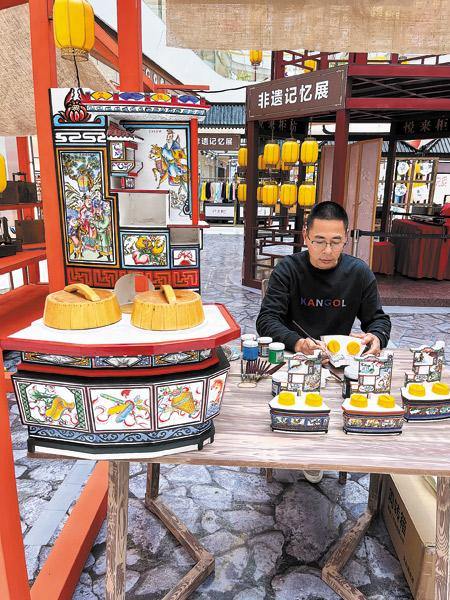
Zhao demonstrates zaotou painting in Haiyan county, Jiaxing. (Photo/China Daily)
Most of those engaged in zaotou painting were bricklayers in rural areas where they were often hired by villagers to build a mud stove in their new home on an auspicious day and paint pictures on the stove.
Tools used to produce such art included a selection of brushes, rulers, and paint.
Folk craftsmen later also came to express life's passions through zaotou paintings.
They first whitewashed the mud-made stove with limewater, and sketched out the patterns based on the shape of the stove, before applying the final coat of paint.
Zaotou paintings are usually in the shape of a square or rectangle, which represent a dignified and upright personality. The paintings depicting animals, the god of fortune, or a story, usually appear on the oven flue while flower patterns are placed at the feet and body of the stove.
"It was to highlight key parts of the stove and create a three-dimensional effect," Zhao explains.
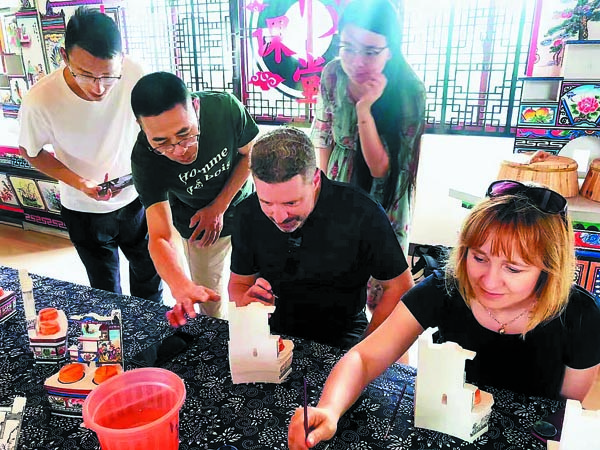
Zhao teaches international guests zaotou painting at his studio in Haiyan. (Photo/China Daily)
As people's aesthetic appreciation grew, watercolours were applied, mostly red, yellow and blue, the three auspicious ones to the Chinese people, he adds.
In modern times, acrylic pigments have taken the place of watercolours and become a mainstream ingredient to solve the colour-fading problem, especially in a humid environment.
"But no matter what material is used, the stove painting is always symbolic and harbours good wishes for the owners," Zhao says.
Whenever Spring Festival arrives, Zhao is swamped with painting zaotou for rural households.
Although villagers have mostly moved into new houses and owned modern gas stoves, they've still been beating a path to Zhao's door, requesting his expertise, especially when some villages have recently upgraded the traditional zaotou into an electricity-powered stove for environmental protection.
"Most villagers are used to the old-fashioned cooking stoves, especially the sense of ritual they bring, so they are reluctant to change," he says.
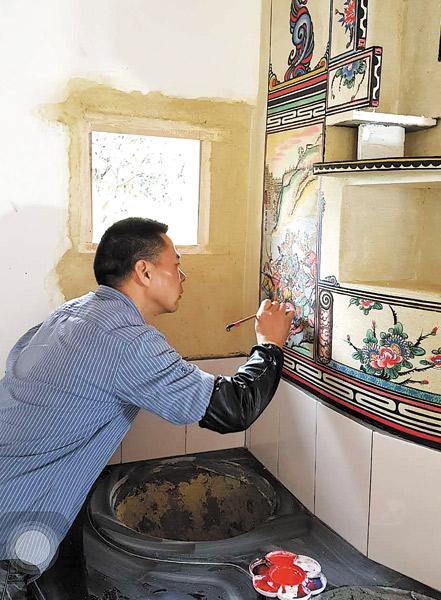
Zhao paints on a zaotou at a rural household in Haiyan. (Photo/China Daily)
As more people are appreciating traditional culture, Zhao's works of art have been pursued by people from across Zhejiang and other provinces, including Anhui and Jiangsu.
"There's been a significant change in the past six or seven years, during which urban people have taken a shine to the old-fashioned stove paintings," Zhao says.
He can also build movable wooden stoves that feature modern induction cookers.
Business owners want it to accentuate the holiday atmosphere or treat their distinguished guests.
"Some of them wait months for me to be available," Zhao says.
At the age of 10, Zhao was exposed to the art form under the influence of his grandfather and father, who were both stove painters.
Whenever Spring Festival came, other children got to play and buy toys, but Zhao's father would take him and his brother to buy illustrated stories and have the boys read them to better understand folk culture and copy the pictures over and over again.
"It is because zaotou painting generally holds propitious connotations, painters need to be familiar with various legendary stories and their expressions while improvising based on the themes requested by customers," Zhao explains.
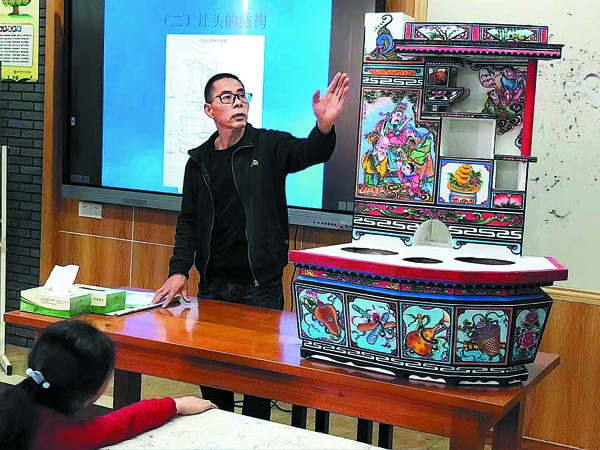
Zhao gives a lesson at a primary school in the county. (Photo/China Daily)
It is also physically demanding. A painter cannot rest his elbow on the mud stove, as it is wet. This is the perfect condition to apply the artwork.
If the surface is dry, the pigment would spread and fade, Zhao explains. As a result, one needs to have a strong arm.
"My father would put a piece of paper on the wall or make me lie under the eight-people table to practice and finish four paintings a day," he recalls.
Since there's no room for error in creating a stove painting, painters need to have both a firm hand and a good command of pigment.
Zhao used to fix a piece of paper on a woven bamboo rice container to steady his hands.
"The container was round and rugged, and if I could paint on it, there would be no problem when it came to the stoves," he says.
As for pigment use, his father would check if his arms were stained with dripped pigment because it would mean he had applied too much of it, which was strictly forbidden.
It was through this stringent training that Zhao acquired a set of solid skills.
He started to build zaotou for other households in the neighbourhood with his father at 17.
A traditional zaotou consists of a base and a body that embraces embedded pans and a chimney pipe, or flue. The stove is usually around 2 meters high and 1.5 meters wide. It is mostly set in a corner of the kitchen, leaving enough space between the back of the stove and the wall so people can tend the fire.
Since Zhao knew stove painting literally like the back of his hand, he could create more visually pleasing zaotou than others.
"After they told me what they wanted, such as how many pots they needed to place on zaotou and the painting themes and numbers, I would plan ahead in my mind," he says.
With growing experiences, Zhao could build a zaotou in three days and finish a set of stove paintings, mostly 10-15 pieces, within one day.
As local authorities have given more support to preserve and develop intangible cultural heritage, zaotou painting has been injected with new momentum.
In Tongyuan, the art form has made its way to educational institutions, ranging from primary schools right up to college.
Zhao has been invited as a regular lecturer to a dozen local schools to teach students the history, culture and skills of zaotou painting.
"We now have this miniature zaotou about the size of a palm for students to try or practice the art," he says.
To date, Zhao has given lectures to more than 1,000 students and he says he takes comfort that many have shown a strong interest.
Cui Huijia, among the culture activity management staff in Xueshuigang village in the town, has been fascinated by zaotou painting, especially after Zhao did one for his renovated stove in 2016.
"It was my childhood memory flashing back," Cui says, and seeing Zhao's work rekindled his passion for the art and had him become an apprentice of Zhao to pursue it in 2018.
"I hope I can contribute to the inheritance and popularization of zaotou paintings," Cui says.
In 2020, Zhao published a collection of his paintings.
"Now that zaotou paintings have been receiving more support from various sides, I'll strive to create more works and reach out to those who show interest," Zhao says.
Editor:Liao Yiyi